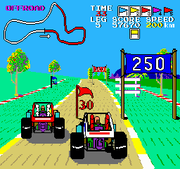
Buggy Boy
Encyclopedia

Driving
Driving is the controlled operation and movement of a land vehicle, such as a car, truck or bus.Although direct operation of a bicycle and a mounted animal are commonly referred to as riding, such operators are legally considered drivers and are required to obey the rules of the road...
style arcade game
Arcade game
An arcade game is a coin-operated entertainment machine, usually installed in public businesses such as restaurants, bars, and amusement arcades. Most arcade games are video games, pinball machines, electro-mechanical games, redemption games, and merchandisers...
developed by Tatsumi in 1985. The object of the game was to drive around one of five courses (Offroad, North, East, South or West) in the shortest time possible. Each course has five legs, each filled with obstacles such as boulders and brick walls. Points are awarded for driving through gates and collecting flags.
The player could also hit logs and tree stumps in order to jump the buggy over obstacles, gaining extra points while airborne. Extra points are also rewarded for driving the buggy on one wheel.
The original, cockpit version of the arcade cabinet was well known for its panoramic three-screen display, a feature previously employed in TX-1
TX-1
TX-1 is a 1983 racing arcade video game developed by Tatsumi. It was licensed to Namco, who in turn licensed it to Atari for release in the United States, thus the game is considered a successor to Pole Position II...
. An upright, single-screen cabinet was released in 1986 under the name, 'Buggy Boy Junior'.
Both versions of the game are supported by the MAME
MAME
MAME is an emulator application designed to recreate the hardware of arcade game systems in software on modern personal computers and other platforms. The intention is to preserve gaming history by preventing vintage games from being lost or forgotten...
emulator.
Commodore 64
Commodore 64
The Commodore 64 is an 8-bit home computer introduced by Commodore International in January 1982.Volume production started in the spring of 1982, with machines being released on to the market in August at a price of US$595...
port of the game was warmly received by the video game press and it became one of the most popular racing games for that platform.

